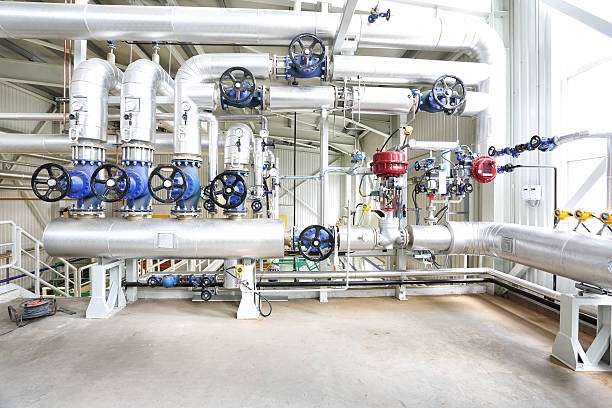
Steam Piping
Effectively steam can be transported through pipe lines to the point of use. Due to reduction in volume due to condensation or utilization from the steam piping network, results in a localized reduction in pressure. This pressure drop through the system creates the flow of steam through the pipes.
Steam at high pressure occupies a lower volume than at atmospheric pressure. The higher the pressure, the smaller the bore of pipework required for distribution of a given mass of steam. Steam velocity in conduit can be considered from 15m/s to 40 m/s based on the pressure. Steam at atmospheric pressure like flash steam at 15 m/s and steam at 3.5 bar at 25m/s and 10 bar and above at 40m/s.
Steam piping are normally insulated with mineral wool for reducing the heat loss and prevention of incident for accidental touching of surfaces. The optimal lagging thickness decided based on the steam temperature, thermal conductivity of piping material and insulation material and environmental condition of the surface. Due consideration shall be considered for convective heat transfer usually in open environment.
The condensate form during transportation must be removed as early as possible from the lowest point in the segment due to following reason.
- Condensate does not transmit heat effectively. A film of condensate inside plant will reduce the efficiency with which heat is transferred.
- When air dissolves into condensate, it becomes corrosive.
- Accumulated condensate can cause noisy and damaging water hammer.
- Inadequate drainage leads to leaking joints.
The steam should be as dry as possible to ensure it is carrying heat effectively. Steam traps are provided to drain the condensate from the piping and prevent steam to escape. There is various type of steam traps used based on the application and economy. Most commonly used traps are as below.
- A float trap uses the difference in density between steam and condensate to operate a Valve. As condensate enters the trap, a float is raised, and the float lever mechanism opens the main Valve to allow condensate to drain. When the condensate flow reduces the float falls and closes the main Valve, thus preventing the escape of steam.
- Thermodynamic traps contain a disc which opens to condensate and closes to steam.
- In bimetallic thermostatic traps, a bimetallic element uses the difference in temperature between steam and condensate to operate the main Valve.
- In balanced pressure thermostatic traps, a small liquid filled capsule which is sensitive to heat operates the Valve.
The condensate which forms will drain easily through a steam trap and sent back to boiler feed water tank through condensate drain piping. If it is contaminated by process fluid, it will be sent to drain. This saves valuable heat energy also saves on water and water treatment costs.
To effectively transporting the condensate back to boiler feed water tank steam operated mechanical power pumps are usually used.
Steam separator are used in the piping to remove moisture from the steam. Usually this contains a series baffles which interrupt the path of the steam. The steam hits the plates, and any drops of moisture in the steam collect on them, before draining from the bottom of the separator.
Important Design Consideration:
Condensate from steam line should be drained at regular interval usually in every 30 -50 m. before the expansion loop, sudden change in elevation, before entering a equipment.
- Pipe sizing is important as the capital investment and operation cost is directly related. Preferably PRS should be close to user point.
- Steam pipeline should be designed with a slope of 1:100, sloping towards the direction of flow. If it is required to be other way i.e. rising then the slope against the flow could be designed about 1:40.
- In main header collection port for condensate is a good design consideration, so that condensate get collected and drained properly.
- Branch/Tap off shall be considered from top of pipeline


Insulation and cladding Contractor
2yHello sir I have a manpower for a Insulation and Cladding work everyone is doing good work , already doing in a gulf
Sr. Manager Quaity Assurance and Quality control. Lean six sigma Green Belt and Black Belt. Certified from ISEL GLOBAL, Lean Manufacturing, ISO 9001:2015 QMS Auditor, DMAIC Problem solving method, 5S Implementation,
2yGreat job sir
Vice President at Morepen Laboratories Limited India
2yGreat Subendu congratulations